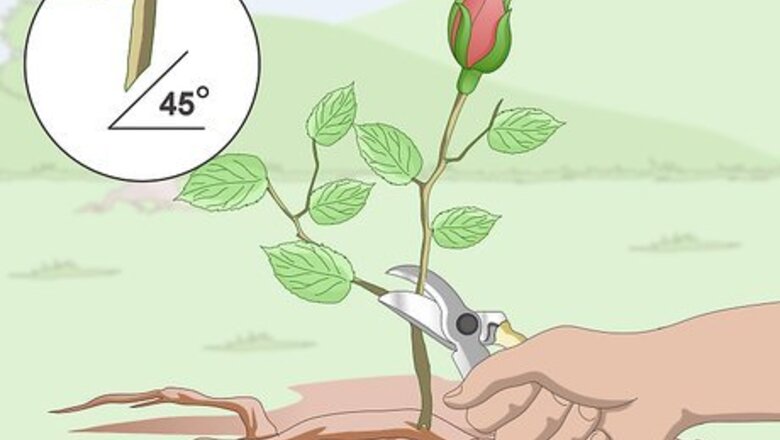
views
Taking a Cutting
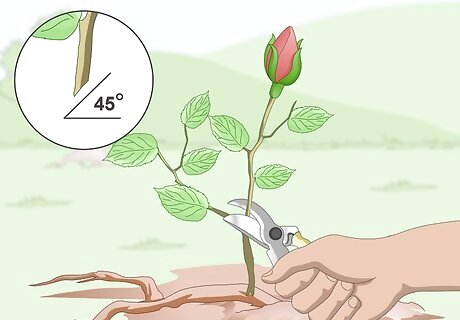
Cut the stem above the first set of leaves at a 45 degree angle. Once you’ve selected healthy rose stems, you’ll want to cut them so that they’re 6–8 inches (15–20 cm) long. Use pruning shears or a sharp knife to cut right above the first set of leaves at a 45 degree angle. Try to take your rose cuttings in the morning so that they’re hydrated. Clean your tools well with rubbing alcohol before you use them. Take your cutting from a younger part of the plant so it will have a better chance of taking root. Roses have compound leaves, meaning smaller leaflets will grow from the stem of the main leaf. Make sure you're cutting above the where the actual leaf attaches to the branch, not above a leaflet. If you can, try to leave 2 nodes above ground for leaves to sprout out of, as well as 2 nodes that will be below ground, where roots can grow.
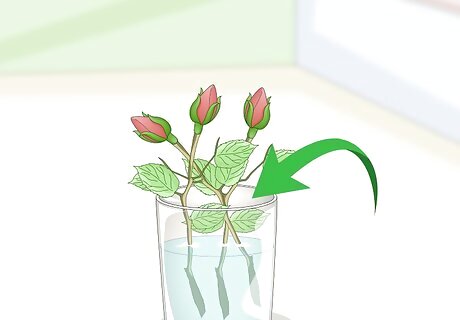
Put the rose cuttings directly into water. It’s very important for the rose cuttings to stay hydrated so that they don’t dry out before you plant them. Immediately after you take the rose cuttings, put them in a cup of room temperature water until you’re ready to transfer them. Ideally, you’ll be ready to put them into the soil right after you cut the stems.
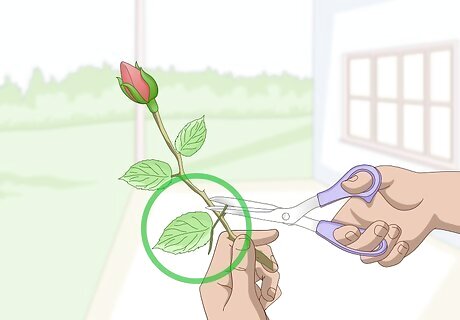
Remove all of the leaves except the ones at the top. Since you cut the rose stem right above a set of leaves, those top leaves are the only ones you’ll want to keep. The rest of the leaves on the stem should be removed using the pruning shears or sharp scissors.
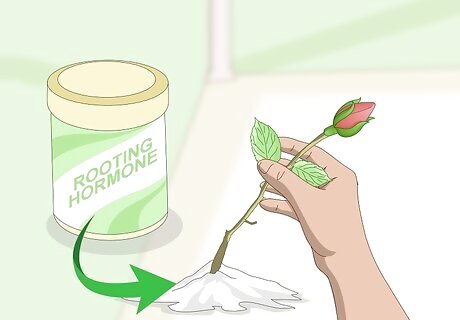
Dip the end of the rose cuttings into a rooting hormone. While this is optional, most people who take rose cuttings use some type of rooting hormone powder to help the cuttings take root. Make sure the base of the rose cutting is damp before dipping it into the powder. Gently tap off any excess powder. Wash your tools with rubbing alcohol again when you're done.
Choosing Healthy Soil and Stems

Pick a sunny spot to plant your rose cuttings. Where you place your cuttings is especially important if you’re planning on growing them outdoors. Choose a spot that’s sunny but that’s not in direct sunlight — you don’t want them to dry out. Putting the rose cuttings in a pot or container is alright as well, just make sure the container is deep and wide enough for your rose cuttings to grow. If you have a sunny spot near a drain pipe or other water source, this is a great choice for ensuring the soil is always moist. The container you’re using should be at least 6 inches (15 cm) deep.
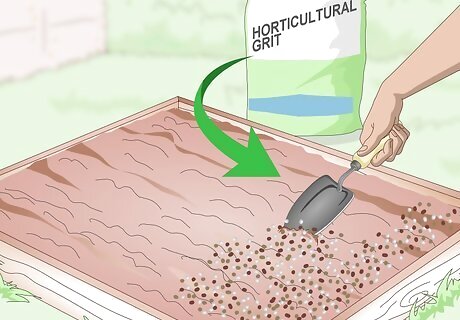
Prepare the soil bed or container for the rose cuttings. For rose cuttings, you want your soil to be made of a mixture of sand and horticultural grit (or perlite). The soil mixture should be able to drain, and be sure to cultivate it 4–6 inches (10–15 cm) deep beforehand. Cultivating the soil requires using a gardening tool, such as a mini spading fork or shovel, to break up the soil so that it's loose. You can purchase sand and horticultural grit from your local home improvement store, or online. A bag of horticultural grit costs $5-$15, while a bag of sand will typically cost less but entirely depends on the size.
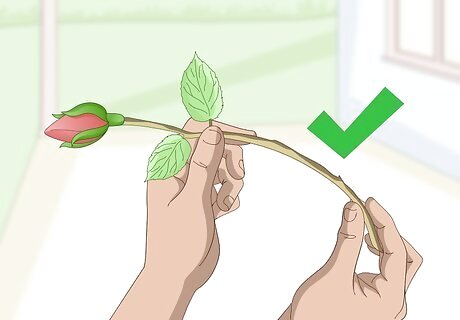
Choose a strong, healthy rose stem. When you go to take your rose cuttings, you want to look for stems that are long, strong, and healthy, meaning no withered or brown stems. It’s best to take softwood cuttings in the late spring or early summer so that they take root faster, so choose stems that are young and flexible.
Growing Strong Roots

Plant the rose cuttings at any point throughout the year. Some people like to plant them during the cool months, while others wait until the early summer. Rose cuttings should be able to grow during any season. However, keep in mind that they'll need to be constantly watered, so if you plant them during the summer or live in a hot climate, they're going to dry out faster. For this reason, the rainy season might be your best option.
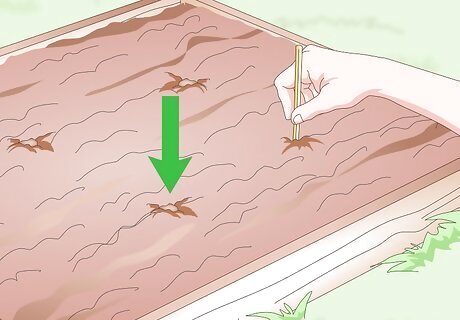
Create holes with a stick or pencil for the cuttings. Use a stick or pencil to make a hole in the soil for each of your rose cuttings that is 3–4 inches (7.6–10.2 cm) deep. You'll want to make sure the holes are wide enough that they won't wipe off the rooting hormone powder when you push the stems into the soil.
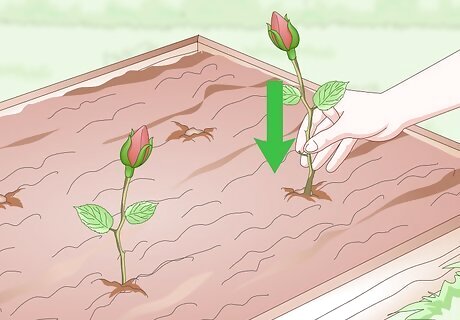
Place the cuttings into the soil. Gently push the cutting down several inches into the soil, or half the length of the cutting. Once the cutting is in place, pat down the soil around the stem. For planting multiple cuttings, place them in rows 6–8 inches (15–20 cm) apart.
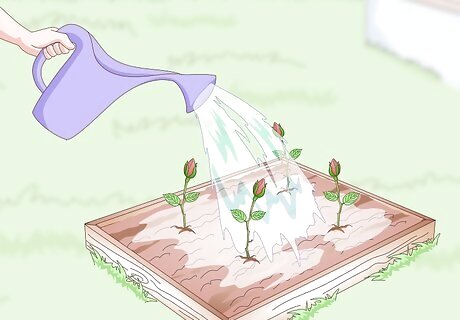
Keep the rose cuttings moist. The most important thing for successful rose cuttings is that they remain moist. Water them frequently, several times a day if the weather is warm, and this will help the roots flourish. To ensure that the moisture remains in the soil, you can place a plastic bag around the cutting once you’ve watered it. This creates a mini greenhouse for the roses.
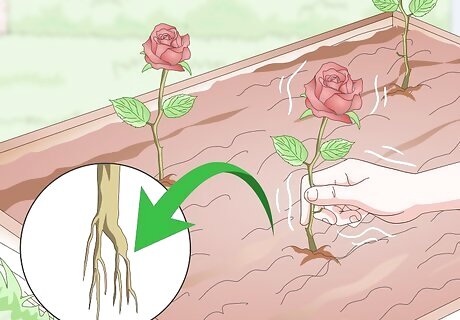
Monitor the rose cuttings to ensure they’re hydrated and taking root. Keep an eye on the cuttings to make sure they’re never dried out, as well as to make sure the cuttings are taking root. You can test to see if the roots are growing by gently tugging on the cuttings. You should be able to feel a slight resistance after a week or 2, meaning the roots are growing well.


















Comments
0 comment